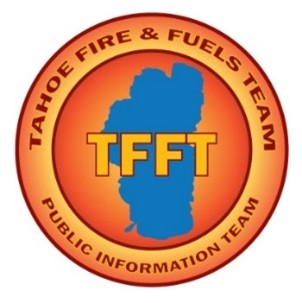2022 Wildfire Outlook for the Lake Tahoe Basin

Contact: USDA Forest Service, Lisa Herron 530-721-3898 or
LAKE TAHOE, Calif./Nev., April 26, 2022 – What began as a promising winter fizzled out in early 2022, leading to the driest January and February recorded across California and Nevada since record keeping began. Closer to home, Tahoe City, which has weather records dating back to 1910, set a record for the driest January through March.
On March 31, 2022, the National Weather Service (NWS) drought monitor noted that 40 percent of California and 36 percent of Nevada is suffering from extreme drought, with severe drought conditions evident in the Lake Tahoe Basin.
“I’ve been with the National Weather Service for over 20 years, and I’ve never seen the winter storm door just slam shut like that,” said NWS Reno’s, Chris Smallcomb. “It’s very unsettling.”
The NWS is predicting drier than normal conditions are likely this spring and warmer than normal conditions are highly likely this summer. Near to below normal precipitation is expected for Northern California, with above normal significant fire potential beginning in May and June across low and mid elevations and in July across all elevations. This means California and Nevada face continued severe to extreme drought that will elevate the risk of wildland fire across both states.
According to the National Interagency Fire Center, since Jan. 1, 2022, 20,262 wildfires have already burned approximately 865,290 acres across the United States. This is well above the 10-year average of 14,522 wildfires and 669,042 acres burned. Above normal significant fire activity is forecast across most elevations including the Lake Tahoe Basin during June and July.
“With the current conditions and predicted outlooks, we are preparing for a fire year similar to the last three – taking all of the lessons that we learned from the Caldor, Dixie and other large fires into consideration,” said Lake Tahoe Basin Management Unit Fire Chief, Carrie Thaler. “We will continue to work closely with our local, state and federal partners in all of our pre-season preparedness activities.”
Lake Tahoe firefighters and land managers use fuels management treatments, such as mechanical and hand thinning, and prescribed fire to reduce excess vegetation buildup that can feed unwanted wildfires. These proactive management actions help protect communities and homes from future wildfires. To complement these actions, there are important steps residents and communities must take to improve community wildfire preparedness at Lake Tahoe.
The time to prepare for the next wildland fire is now. Last year’s Caldor Fire revealed how wildland fires outside of the Tahoe Basin can easily spread into our area and threaten homes and communities. Remember it’s not a matter of “if” the next wildfire will occur, it’s a matter of “when”.
The Tahoe Fire & Fuels Team encourages homeowners and residents to take responsibility for preparing their families, homes, and property for the next wildfire. Everyone living in the Tahoe Basin should complete defensible space clean up around their homes and property; develop and review evacuation plans; sign-up for reverse 911 notifications; contact local fire districts to schedule free defensible space evaluations; learn about free chipping services; and talk to neighbors about the importance of wildfire preparedness.
It is also important to know what a Red Flag Warning is – those days with strong winds and low humidity resulting in rapid fire spread and less time to react. All this information and more is available on the Tahoe Living with Fire website at www.tahoelivingwithfire.com/.
Additionally, Lake Tahoe visitors can do their part to prevent wildfires by understanding when and where wood and charcoal fires are permitted before igniting a fire. National Forest lands around Lake Tahoe are under year-round fire restrictions. This means wood and charcoal fires are only permitted in provided metal fire rings and grills in open, developed campgrounds.
Wood and charcoal fires are never permitted in the following locations: Desolation Wilderness, Meiss Country or any other backcountry location; beaches or picnic areas; or anywhere else in the forest. Propane appliances with on/off valves are allowed with a valid California Campfire Permit available at www.readyforwildfire.org/permits/campfire-permit/.
Another step toward wildfire preparedness is to sign-up for the Tahoe Network of Fire Adapted Communities (Tahoe Network) newsletter. The Tahoe Network provides community members with education, communication, and advice; facilitates collaboration between communities and stakeholders; helps communities organize events and neighborhood-level vegetation removal projects; and tracks community accomplishments. For more information about the Tahoe Network program, visit www.tahoelivingwithfire.com/get-involved/.
It’s up to all of us living in, visiting, and recreating in the Tahoe Basin to do our part to prepare for and prevent the next wildfire. To learn more about living with fire, visit www.tahoelivingwithfire.com/get-informed/understanding-fire/.
###
About the Tahoe Fire and Fuels Team
The Tahoe Fire and Fuels Team (TFFT) consists of representatives of Tahoe Basin fire agencies, CAL FIRE, Nevada Division of Forestry and related state agencies, University of California and Nevada Cooperative Extensions, the Tahoe Regional Planning Agency, the USDA Forest Service, conservation districts from both states, the California Tahoe Conservancy, and the Lahontan Regional Water Quality Control Board. Our Mission is to protect lives, property and the environment within the Lake Tahoe Basin from wildfire by implementing prioritized fuels reduction projects and engaging the public in becoming a Fire Adapted Community.
For more information, visit https://tahoe.livingwithfire.info/about/.